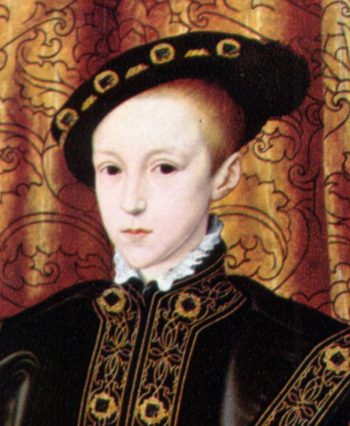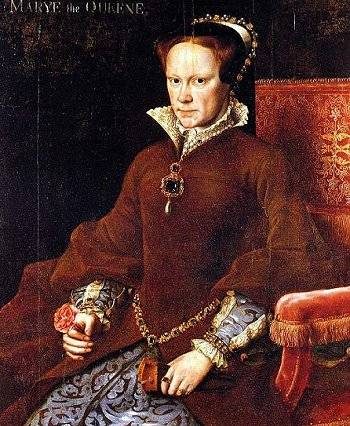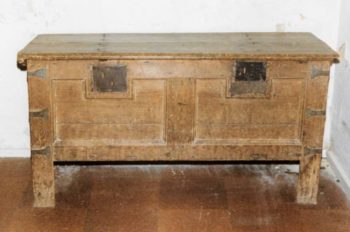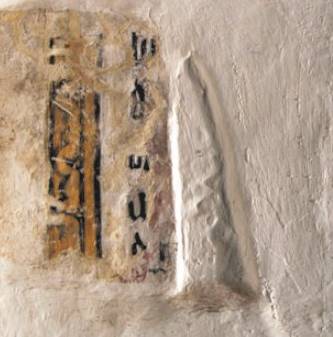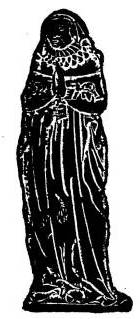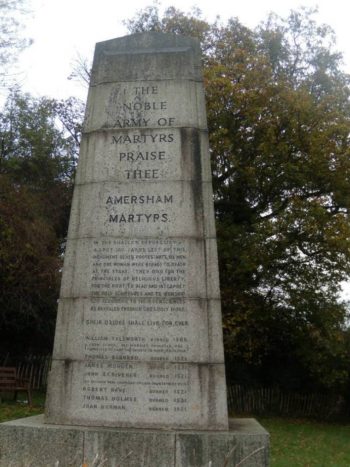Penn Church and the Reformation:
Introduction:
This project was written as an assignment for the St Alban’s and Oxford Ministry Course. Based on information from 16th century records, and evidence visible in the church today, it is a history of the church of Holy Trinity, Penn, and religion of the people of Penn from the early 1500’s to around 1600. The sixteenth century covers the reigns of Henry VIII, 1509-1547, Edward VI, 1547-1553, Mary Tudor, 1553-1558, and Elizabeth I, 1558-1603. This is the period which is broadly described as ‘The Reformation’, a period of unprecedented change in European religious thought and practice. In quiet country villages such as Penn, the Reformation abruptly changed almost everything which was familiar within the parish church, the centre of village life, and in the religious ritual and practice which had ordered peoples lives for centuries.
Format of this Project Document
The first part of this document is an essay addressing the question of how the Reformation might have affected Penn.
The second part is a reference section with material copied from many sources, as background to support the first part. The sixteenth century is rich in surviving records for the diocese of Lincoln, of which Penn was part, and for the state records of the Tudor period, and I was surprised to find how many of these are readily accessible, transcribed in modern publications.
Acknowledgements
I have drawn from many sources, mainly books in the High Wycombe and Aylesbury reference libraries and also from modern books by Reformation historians. However my special thanks must go to Miles Green, our local historian, (and Clerk to Penn Parish Council). As I started out on this project, Miles spent time, pointing me to the likely sources of information, and also gave me a copy of the relevant part of his unpublished history of Penn. But, more importantly than that, over many years, Miles’ talks on local history and his articles in local publications fired my interest in the history of Penn and Tylers Green, which made this project so enjoyable.
© Peter Strutt, June 1996
A Brief History of the Reformation in England
The Reformation is often discussed as if it were a deliberately planned and pre-meditated event. In fact the Reformation happened more by accident, than design, and the final outcome, of the church in Europe split into ‘Catholic’ and ‘Protestant’ groupings, was far from the original intention of the reformers. The European reformers, particularly Martin Luther, had hoped to reform the Catholic Church from within. To an extent they achieved their objective with the Council of Trent, (1545 to 1563), which initiated the ‘Counter-Reformation’, more accurately described as the ‘Catholic Reformation’. But Trent was too late, the split was by then irrepairable and the reforms introduced were not far-reaching enough to have satisfied the ‘Protestant’ reformers.
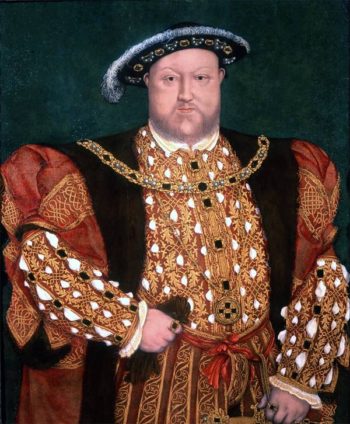 Henry VIII is credited with initiating the Reformation in England, but unlike Luther, Henry’s objective was not theological, but political, which led, again almost by accident, to the reformation of the Church in England. Henry needed a son and heir, but of the five children of his marriage to Catherine of Aragon, who was his brother’s widow, only one, Mary Tudor, had survived. In order to secure the succession of the throne through a male heir, Henry needed a new wife, and Anne Boleyn who had become his mistress at court filled that requirement. All he needed was an annulment of his marriage to Catherine, (on the grounds that it had been illegal for him to marry his brother’s widow), which the Pope could provide. But the Pope also for political reasons, couldn’t allow Henry’s divorce, because he was effectively a prisoner of the Holy Roman Emperor Charles V, who happened to be Catherine of Aragon’s nephew. Henry split with Rome and declared himself Supreme Head of the Church of England. He married Anne Boleyn, and Thomas Cranmer, as archbishop of Canterbury, declared his marriage to Catherine null and void.
Henry VIII is credited with initiating the Reformation in England, but unlike Luther, Henry’s objective was not theological, but political, which led, again almost by accident, to the reformation of the Church in England. Henry needed a son and heir, but of the five children of his marriage to Catherine of Aragon, who was his brother’s widow, only one, Mary Tudor, had survived. In order to secure the succession of the throne through a male heir, Henry needed a new wife, and Anne Boleyn who had become his mistress at court filled that requirement. All he needed was an annulment of his marriage to Catherine, (on the grounds that it had been illegal for him to marry his brother’s widow), which the Pope could provide. But the Pope also for political reasons, couldn’t allow Henry’s divorce, because he was effectively a prisoner of the Holy Roman Emperor Charles V, who happened to be Catherine of Aragon’s nephew. Henry split with Rome and declared himself Supreme Head of the Church of England. He married Anne Boleyn, and Thomas Cranmer, as archbishop of Canterbury, declared his marriage to Catherine null and void.
However, Henry VIII remained a Catholic to the end of his life, and he upheld all the important Catholic doctrines. The reforms he made in the church were chiefly aimed at eliminating superstition and the veneration of images and relics. When Henry died in 1547, his son Edward VI was only nine years old. The real Reformation in doctrine and liturgy came during Edward’s reign, influenced largely by men like Thomas Cranmer and like minded reformers who had the young king’s ear and brought him up to be a good Protestant. The Latin mass was abolished and replaced by the Prayer books of 1549 and then 1552, and images and statues were removed from churches, changing forever the Medieval interior decoration of our parish churches.
Edward died of tuberculosis in 1553, aged 16, and his sister Mary Tudor acceded to the throne. Mary was through and through a Catholic and attempted to reverse the changes of Edward’s reign, taking the church back to Rome. She died in 1558, after only five years, and was succeeded by her sister Elizabeth.
Under Elizabeth the church in England returned to something like it had been under Edward. Elizabeth declared herself ‘Supreme Governor’ of the Church of England and re-established the 1552 Prayer Book of Edward VI with only minor revisions.
It is against this background of the Reformation in England, that we can look at the historical evidence and try and build up a picture of how the turmoil of the Reformation affected the lives of the people of Penn, and the church.
Penn Church before the Reformation
To appreciate how drastically the Reformation changed our parish churches and the traditional worship of the people, it is interesting to try and reconstruct the appearance of Penn church in the early 16th century. Structurally the building has changed very little. Penn is a 12C church, possibly on earlier foundations. The nave, the lower walls of the chancel and the lower stories of the west tower, all date from the 12C to 14C. The south aisle was added in the 14C, and the north porch (and original south porch) in the 15C. The chancel and Lady chapel were rebuilt on the original walls, in 1736, after a fire, and at the same time the arch at the east end of the south wall of the nave, by the present pulpit was widened, and the chancel arch was reshaped. Otherwise the church is remarkably as it was in the 16C, having somehow escaped the attentions of the Victorian restorers.
Although the structure may be much the same, the internal appearance of the church would have been very different at the start of the 16C. Between the nave and the chancel would have been the carved wooden Rood screen, probably highly decorated. On the beam over the screen was fixed the Rood or cross of Christ, carrying a painted carved image of Christ, perhaps not quite life size, and rather like a modern crucifix. Either side of the Rood, on the beam, hung two statues, on the left the Virgin Mary, the mother of Christ, and on the right, the apostle John. Behind and over the rood in the chancel arch, the Penn Doom, the only link with the appearance of the church interior today. Below the beam on top of the Rood screen, would have been the Rood loft, or gallery, which gave access to the Rood, and on the loft burned lights before the images of Christ, the Virgin and St. John. There would certainly have been many other statues around the church, with lights burning before them. One we know of, from the will of Wyllyam Grove, who died in 1513, was an image of the Trinity. A surviving statue of the Trinity found in a walled-up niche at Kilkenny in Ireland, shows God the Father as an old man, combined with a crucifix (Christ on the cross) and a dove1. Wyllyam Grove, rather quaintly bequeathed ‘vnto the rode lyght of Penne i shepe’, and ‘to the trinite i shepe‘. It is difficult to imagine what the church would do if it were left two sheep in someone’s will, but doubtless the church wardens of 1513 took it all in their stride.
Instead of the plain white of today, the walls of the church were painted with coloured scenes taken from scripture or the lives of the saints. The church at Little Missenden, less than four miles away has wall paintings in monochrome red ochre over white walls, which cover almost the whole of the interior of the church. During restoration work at Penn in 1953/4, considerable evidence of painting was found on the walls, some of which in red and yellow ochre can be seen today on the south wall of the nave by the pulpit, suggesting that Penn’s paintings were in several colours..
It is also likely that Penn would have had coloured stained glass windows with similar images. The present glass is almost all 20C, any medieval glass having been destroyed or removed at the Reformation. The whole effect would have been reminiscent of Catholic churches in some parts of Europe today, which we would consider over-decorated, compared with the sometimes austere beauty of our English parish churches.
Penn is remarkable, in that 450 years after the Reformation, there is still a surprising amount of physical evidence which gives us an insight into the pre-Reformation appearance of the church. The beam over the chancel arch has clearly visible the channel or socket cut in it to take the upright of the Rood or cross. Either side of this are the hooks which held up the statues of Mary and John. The Penn Doom was rediscovered when some old boards were removed from over the chancel arch in 1937/8, and thrown out into the churchyard. A workman found coloured paint on them and they were subsequently reassembled and the Doom is now fixed in much the position it has had for almost 600 years. The purpose of the Doom, behind the Rood, was to remind people ‘that only Christ’s sacrifice on the cross stood between them and a disagreeable fate’2. By the beam over the chancel arch, is a depression in the wall, about 2ft wide, by 4 ft high. by 6 inches deep, which would have supported the end of the Rood loft, and also may have been the entrance to the loft from a now lost staircase. Records of Buckinghamshire, Vol 44, 2004
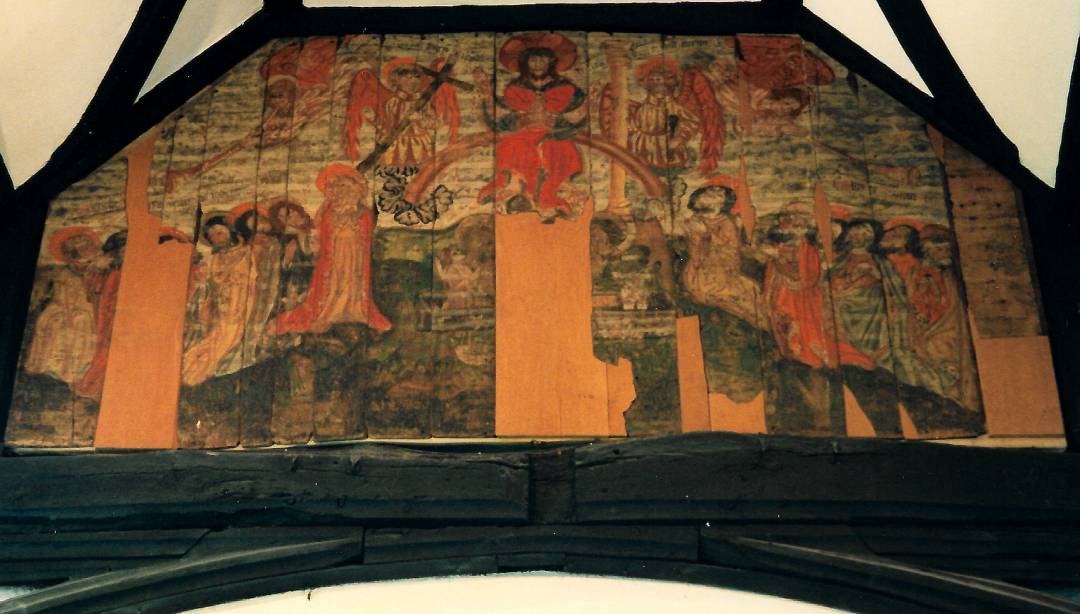 The Penn Doom in the east arch of the nave, with the beam showing the socket for the vertical of the Rood,
The Penn Doom in the east arch of the nave, with the beam showing the socket for the vertical of the Rood,
below are hooks from which would have hung statues of the Virgin Mary and St. John.
It is sometimes difficult for us to accept that from the very first church at Penn, up to the Reformation, Penn was what we would understand as ‘the Catholic church’. The services and liturgy would have been very different to the Book of Common Prayer services we are used to, and to us would have been very high Catholic. Services were almost completely in Latin, with complicated ritual and rich and ornate vestments and ornaments used in procession around the church. We know from an inventory of 1552, that amongst other items, Penn still had ‘iii vestymentes, ii copes of silk, a pixe’, or pyx to contain the reserved sacrament, and a canopy to go over it, at a time when many other items may well have been already disposed of. From the surviving inventories, High Wycombe parish church must have been extremely rich and ornate, and attending a service there would have been on a par with one of the great cathedral churches, for splendour and liturgy.
The chancel behind the Rood screen was effectively closed to the lay people, except once a year, at Easter, when they were allowed to take communion, in one kind, the wafer only. The chalice was kept from them in case they profaned the blood of Christ. The mass was celebrated much more often than that however, perhaps even daily, the ordinary people were expected to participate in the service, but only the priest and server took communion. The sanctus bell was rung three times to attract the congregation’s attention and secure silence for the consecration of the bread and wine3. The man who rang the sanctus bell at Penn, must have stood inside the nave of the church by the west door, with the bell rope under the arch. The grooves worn by the bell rope during countless Latin masses can be clearly seen today in the tower side of stone arch of the west door. The sanctus bell itself, no longer used, probably remained in the tower until 1702, when all the bells were recast4.
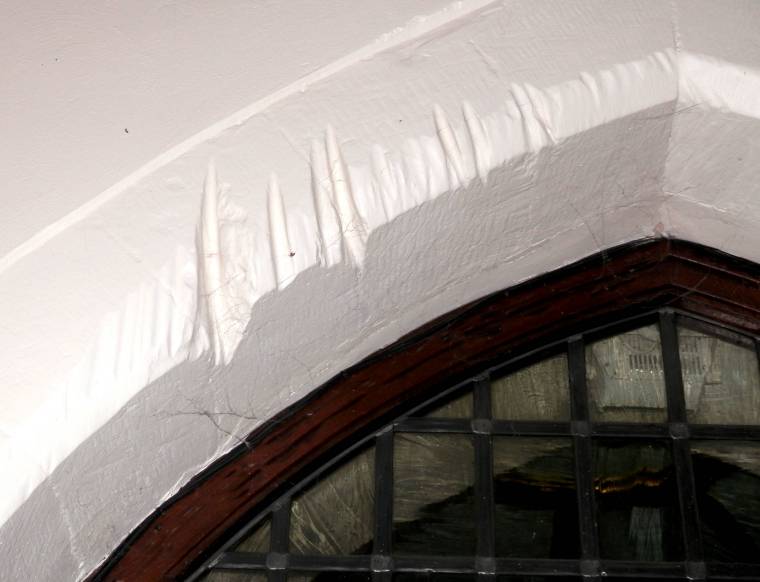 The west arch of the nave showing the grooves worn in the stonework by the sanctus bell rope.
The west arch of the nave showing the grooves worn in the stonework by the sanctus bell rope.
This then was a picture of the church and worship at Penn at the start of the 16C. Over a period of a few years, most of it concentrated into Edward VI’s reign of six years, the interior of the church was transformed to be much as we see it today, and the worship was conformed from the Latin mass, to an early version of the Book of Common Prayer, which we would certainly recognise today. When we consider the impact of comparatively minor changes today, the impact on the congregation at Penn must have been profound, with all that was familiar and dear to them changed at the whim of the king.
The impact of the Reformation on the church
Henry VIII’s divorce from Catherine and marriage to Anne Boleyn happened in 1533, and resulted in his split from Rome. Henry rejected the authority of the pope over England, and so over the church of England. He declared himself ‘Supreme Head of the Church of England’, and it was this action which effectively opened the way for the Reformation. Henry had no intention of changing the Catholic doctrine of the church of England, and his reforms were aimed at what he considered to be the worst excesses of the practice of the Catholic church. The monasteries were Henry’s first target for reform, partly because they were seen to morally and financially corrupt, which was certainly true of some, but not all, but also because the monasteries controlled vast resources of land and property, which became a target for Henry’s asset stripping. At the Dissolution of the Monasteries, these passed to the crown, and were sold to the highest bidder or given as favours.
Up to this time, the church and manor of Penn, with its rectory, that is the rents it collected, and its advowson, the right to appoint the vicar, belonged to Chalcombe priory in Northamptonshire. At the Dissolution, they passed to the Crown, and in 1540, they were given to Sybil Hampden, the wife of David Penn, of Penn, and have passed down in the same family to the present Lord Howe who still lives in Penn, at Penn House. Sybil Hampden provides a fascinating link between Penn and the Reformation. The future Edward VI was born to Henry’s third wife, Jane Seymour, who died soon after the birth. Sybil Hampden became nurse to the young prince, and the gift of the manor of Penn and the right to appoint the vicar, was a reward for her services. Sybil’s special relationship with the Tudor monarchs lasted all her life. Through prince Edward, she was clearly well known not only the Henry VIII, but also to Elizabeth. In 1561, she was granted by Elizabeth I, “60 french crownes amounting to £18 sterling to be given by way of our rewarde for a New Yeres gift to [Sybil Penn] sometyme nource to our dear and beloved brother King Edward the Sixt”. Sybil died of smallpox on 6th November 1562, and was buried in Hampton church, near Hampton Court palace.
The impact of change during Henry’s reign was probably minimal. In 1536 and again in 1538, a Bible in English was ordered to be placed in every church, and the inventory of 1552 shows Penn as having a Bible, (whilst intrigingly, almost all other Buckinghamshire inventories make no mention of a Bible). Also every parish church was required to keep a register of baptisms, marriages and burials, in “a sure coffer with two locks”5. Penn has registers from 1560. It is interesting to speculate that the wooden chest by the font with two locks and an internal lockable compartment was made to contain the parish registers.
At this time, the Lord’s Prayer, the Creed and the Ten Commandments were ordered to be read in English every Sunday and taught to children. There was a general discouragement of veneration of images and relics, and in 1538, an order for the removal of images to which pilgrimages and offerings were customary, (although these injunctions were not universally obeyed). In general, Henry VIII was concerned to reinforce the basic doctrines of the Catholic church such as clerical celibacy, communion in one kind and transubstantiation (the belief that the bread and wine become the physical body and blood of Christ when they are consecrated at the Eucharist). Right up to his death, he considered himself to be a Catholic, and the church of England to be Catholic, having little sympathy with the European reformers.
The same was not true of Henry’s archbishop of Canterbury, Thomas Cranmer and other influential men of Henry’s court. When Henry died, in 1547, the young prince Edward was only nine years old, and he was surrounded by men who were determined to bring him up as a Protestant, and to reform the church of England. In 1548, the Latin mass was still used, but followed by a communion service in English, with both bread and wine administered to the lay people. Stone altars were to be removed and replaced by wooden tables, and an order was made for the removal of any remaining images from churches. The wall paintings and images in many churches were often a strange mixture of sacred and profane, occasionally with bizarre details from the lives of local saints, or local legends, which the reformers considered to be both unedifying and leading to superstition and the worst kind of folk religion.
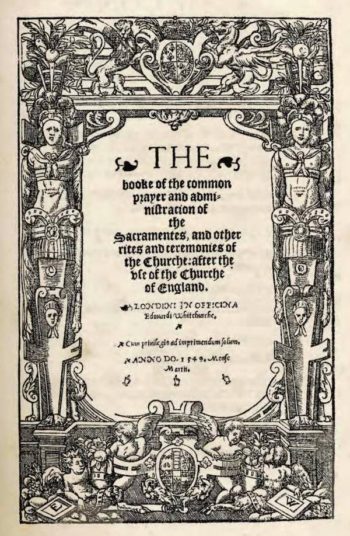 In 1549, Cranmer’s first prayer Book was published, with all the services in English, its exclusive use forced by an Act of Uniformity, and the Latin mass was prohibited. In some places it was welcomed, in others it provoked riots and even an armed rebellion in Cornwall. Generally Buckinghamshire seems to have recorded very little resistance to the changes, but the effect on the worshipping congregation must have been profound. The will of Roger Playter, proved 5 April 1549, bequeaths 2d. to the rood light, and 4d. to the priest to say ‘masse in the chapell for my soule at a time convenient’. Perhaps this indicates that the rood light and the lady chapel were still operating as before, or that events had overtaken Roger Playter’s will since it was written. But from Whit Sunday, June 9th 1549, the Latin mass was prohibited, and the Prayer book the only authorised services.
In 1549, Cranmer’s first prayer Book was published, with all the services in English, its exclusive use forced by an Act of Uniformity, and the Latin mass was prohibited. In some places it was welcomed, in others it provoked riots and even an armed rebellion in Cornwall. Generally Buckinghamshire seems to have recorded very little resistance to the changes, but the effect on the worshipping congregation must have been profound. The will of Roger Playter, proved 5 April 1549, bequeaths 2d. to the rood light, and 4d. to the priest to say ‘masse in the chapell for my soule at a time convenient’. Perhaps this indicates that the rood light and the lady chapel were still operating as before, or that events had overtaken Roger Playter’s will since it was written. But from Whit Sunday, June 9th 1549, the Latin mass was prohibited, and the Prayer book the only authorised services.
The Prayer Book is another link between the Reformation and today. The 1662 Prayer Book which Penn uses, is certainly changed and revised since 1549, but is still recognisably based on Cranmer’s first Prayer Book. A further link is the Merbecke musical setting written in 1550, which is used once a month for the Sung Eucharist at Penn. John Merbecke was organist at St. George’s Chapel in Windsor. In 1544, he was condemned to the stake for heresy because he had written the first concordance in English of the Bible. He was pardoned and the concordance was published in 1550 with a dedication to Edward VI6. Merbecke’s experience of being condemned to be burned for heresy under Henry VIII in 1544, and then having the same book published with a dedication to King Edward VI, only six years later, is a good example of how quickly the events of the Reformation moved, and how drastically official policy changed, especially in Edward’s reign. This same rapid change was reflected in the appearance and worship of our parish churches.
1552 saw the second English Prayer book, which reflected much more the influence of the European reformers, and was distinctly more Protestant in tone, and in 1553, the Forty-two articles of religion, the basis of our Thirty-nine articles. By the time of Edward’s death from tuberculosis in 1553, after only six years, the English reformation was to all intents and purposes complete.
The Roman liturgy and ritual had been swept away, the walls of our parish churches were lime-washed over, and instead of the colourful wall paintings, sentences of scripture were painted on the walls. Evidence of these still exists on the east end of the south wall of the nave behind the pulpit. There appear to be several generations of sentences on this wall, with evidence of an earlier wall painting beneath them. This was expensive work which had to be paid for by the parish. No churchwardens’ accounts exist for Penn, but Houghton in Bedfordshire paid £6 for “scrypturying and other payntying of the churche” and Beckingley in Surrey paid £6 15s. 2d. for the same work7. The Doom was probably painted over at this time, and replaced by a banner carrying the royal arms, the Commandments and sentences of scripture.
Any painting or statue which survived the 16C, was finally destroyed in the mid-17C by Oliver Cromwell’s army. It has been estimated that the destruction of the 16th and 17th centuries, was so thorough, that 95% to 99% of all church art was destroyed in England. Not a single figure of Christ on the cross survives from before the Reformation, which is remarkable when we consider that every parish church, monastery and religious house would have had at least one, or more.
Edward was succeeded in 1553 by his sister Mary Tudor. Mary was the daughter of a Catholic mother, Catherine of Aragon, and had no love of the Protestant reformers, who had declared her mother’s marriage invalid and in so doing had declared her to be illegitimate. Many of the reformers, including bishops Latimer and Ridley and Thomas Cranmer, went to the stake for their beliefs during Mary’s reign. Within a month of her accession, the Latin mass was reinstated and the Prayer Book banned. Stone altars were to be rebuilt, the roods reinstated, and parishes at their own expense had to replace vestments, candlesticks, and all the other items which had so recently been appropriated by the crown. We can only surmise the effect of this on Penn. Most people were probably relieved that the old ways of religion were being revived, some disappointed that the new reforms were so soon abandoned. Probably the great majority of people were left both confused and insecure. The church, the one thing which should have been stable in a changing world was now the main agent of change in their lives, most people must have been totally confused as to which side of the line their salvation in Christ was assured.
Mary died after only five years and was succeeded by her sister Elizabeth, the daughter of Anne Boleyn. Elizabeth had Protestant sympathies, her mother had been a protegé of Cranmer’s, and by Roman arguments, she would herself have been illegitimate. Having lived through the turmoil of three successive reigns, Henry VIII, Edward VI and Mary, when her own life had been in danger, Elizabeth tried to take a middle line and conciliate both Catholics and Protestants. But her hand was forced by Parliament and within a year, the Book of Common Prayer was reinstated in a 1559 revision, with the queen as Supreme Governor of the Church of England. Mary’s reversion to the Catholic religion was unravelled and England was again a Protestant country. The changes this made to the parish church must again have been traumatic, although by now almost familiar, having been through it all twice before! Elizabeth’s reign of 43 years marked a period of comparative stability in religion, which was to last until the Civil War in 1642.
The impact of the Reformation on the people
Recusancy
Perhaps the deceased Roger Playter got his mass in the Lady chapel before the Latin mass was proscribed in 1549, but the impact on those who lived through the changes must have been profound. Having been taught all their life, that they could buy their way out of the horrors of purgatory by paying to have masses said for their soul, or leaving money for lights to be burnt before the Rood or the saints, or to benefit the poor, the new religion swept all that away and left them with only a total reliance on the grace of God for their salvation8.
We might assume that eventually everyone conformed to the new religion, but there is evidence to show that this was far from the fact. There were people who clung resolutely to the old faith. The most significant of these being the Penn family, who were both the lay rector, and patron, responsible for appointing the vicars of Penn. In 1584, John Penn and his wife Ursula, whose brass is in the south aisle of the church, were listed as absentees from the church, at a time when attendance was required by law. Ursula was accused the following year of recusancy, that is keeping to the old Catholic faith and refusing to attend the Church of England services. Ursula and a Thomas Penn agreed to pay a fixed annual fine, in return for exemption from the penalties for recusancy. Ursula Penn is still listed for recusancy in 1602, Alice Penn in 1610, and Martha Penn in 1635, some 80 years after Edward’s accession and the full impact of the Reformation.
In 1587, John Gardiner, the lord of Segraves manor, the ‘Manor House’ about 200 yards west of Penn church, was imprisoned for aiding and sheltering Catholic priests, at Grove Place in Chalfont St. Giles, only four miles from Penn. His fate in not recorded, but two years later another of the Buckinghamshire gentry was executed for the same offence. 1587 was not a good year to be accused of papist sympathies. The Catholic claimant to the throne, Mary Queen of Scots was executed in 1587, and the Spanish Armada sailed in 1588-1590, with the express intent of deposing Elizabeth and restoring the Catholic faith to England. Catholicism was by no means dead in England, as the Gunpowder plot in 1605 proves. As far as the records show, recusancy was restricted to the gentry. The Camoys of Stonor, near Henley, are famous for having held to the Catholic faith to this day. Recusancy was only possible if you were rich and could afford to pay the heavy fines. It is likely that the common people made an outward show of conformity, and as an older generation brought up as Catholics died out, their children and grand-children were brought up as Protestants in Elizabeth’s Church of England. It is difficult for us living in an age of religious pluralism and tolerance, with many denominations existing side by side in England, to understand the necessity of conforming to one national religion in the 16C. But the issue then was very clear, if you were a Catholic, you owed your allegiance to the Pope, and by definition, you rejected the authority of the king (or queen). To be a Catholic was tantamount to treason, although in practise, most Catholics who held resolutely to their faith, were loyal to Elizabeth.
Lollardy
Long before the start of the Reformation, there was a movement among the common people, particularly it seems among the skilled artisan classes, towards what was called Lollardy. The Lollards originate in the 15C, and even 14C, as a reaction to the Catholic religion, with much the same aims as the reformers of the 16C. From bishop Longland’s register of 1521, the chief ‘crimes’ of the Lollards were, “reading the Bible in English, rejection of transubstantiation (they denied the bodily presence of Christ in the Eucharist), a rejection of the veneration of images, and opposition to pilgrimages”9, which by 1553, were all perfectly respectable doctrines. It would be too sweeping to say that Lollardy in England was a contributor to the Reformation, but it provided fertile soil for Reformation ideas to take root. The Chilterns was a notorious centre for Lollardy, with Amersham and High Wycombe two of the main centres. The Martyrs Memorial off Stanley Hill in Amersham commemorates the Lollard martyr William Tylsworth, burnt there in 1506, recorded in Foxes Book of Martyrs. Penn equidistant between Amersham and High Wycombe could not fail to have been affected by Lollard ideas. Two parishioners of Penn are mentioned in bishop Longland’s register of 1521, Edmund Hill and John Frier. Frier is said to have taught the Ten Commandments in English to William Littlepage (also thought to be a Penn man), and to have been a servant of the Penn family10. At least four more local heretics were burnt in 1521, four years after Martin Luther nailed his 95 theses to the church door in Wittenberg, and only 26 years before their views would have been orthodox in Edward VI’s England.
An interesting event occurred on July 16th 1553, ten days after Edward VI died. The celebrated reformer and preacher John Knox, preached at Amersham parish church. He had the full authority of the Privy Council, and his objective was no doubt to stir up opposition to the accession of Mary, who was proclaimed queen four days later on July 20th11. Gilbert Jenkins in his History of Penn, quotes from Knox’s writings:–
“In wrytnge herof it came to mind after the death of that innocent and moste godlye Kynge, Edward the Sixte, whyle that great tumulte was in Englande for the establyshing of that most unhappye and wicked womane’s authoritie (I mean of her that now raigneth in Goddes wrathe (i.e. Mary)), entreatinge the same argument in a towne in Buckinghamshyre, named Hammershame, before a great congregation, with sorrowful herte and wepynge eyes, I fel into this exclamation :–
‘O Englande ! now is Goddes wrath kyndled against thee. …. ‘
‘But, O Englande, Englande ! yf thou obstinately wilt returne into Egypt, that is, if thou contract mariage, confederacy, or league with such princes as do mayntayne and advaunce ydolatrie (such as the Emperoure, which is no less enemie unto Christe than ever was Nero) yf for the pleasure and friendshippe (I say) of such princes thou returne to thy olde abhominations, before used under the Papistrie, then assuraedly, O Englande, thou shalt be plagued, and brought to destruction. by the meanes of those whose favoures thou sekest, and by whom thou art procured to fall from Christ and serve Anti-Christ’.12“
Amersham church is only three miles from Penn, and it must be almost certain that there were Penn people among the ‘great congregation’ to hear Knox on that day. As Jenkins says, “One wonders what the reactions of the homely folk of Amersham and Penn were to this forceful Jeremiad”. On Mary’s accession, Knox was forced into exile, first in Frankfurt, from where he was ejected for expressing his opinions about the Emperor, and thence to Geneva, the home of Calvinism, which was to be the basis of the Scottish Reformation, precipitated by Knox when he returned to Scotland in 1559.
The Clergy of Penn
The other group of Penn people significantly affected by the Reformation were the clergy. The vicar throughout the turbulent years of Henry and Edward’s Reformation was William Egleston (or Eccleston). He became vicar in 1530, three years before Henry’s break with Rome, and died in the same year as Edward VI. When he took office, he was a Catholic priest, presumably celibate. When he died he was a priest in the reformed Church of England. “In 1539, he was committed to Aylesbury gaol on account of the utterance by him of certain opprobious words, his accusers being Thomas Grove and William Culverhouse, probably the churchwardens13. The exact nature of his offence is not known, and he must have been very soon reinstated at Penn. An episcopal visitation of 1540 records him as vicar, with a note that he was suffering from the plague”14. Perhaps he was unwise enough to remark on the changes being made to the Catholic religion by Henry VIII. We know little more about him, other than that he might have married. The parish register for 15th October 1570, shows a marriage between “Jn. Egleston and Essabell Salther wid”, possibly William Egleston’s son. William Egleston was responsible with the Churchwardens for implementing the whole of the changes to the church and religion of Henry’s and Edward’s reign. He must have agreed to conform to the Prayer Book and Forty-two articles, but other than that he was licensed to preach twice a year, we know nothing else about him.
He was succeeded by Thomas Kyng in 1553, the year of Mary’s accession. He was the first vicar to be appointed by David and Sybil Penn, who had acquired the patronage as a gift from Henry VIII in 1540. Without Thomas Kyng’s exact dates, it is impossible to know if he was appointed as a Protestant and almost immediately had to revert to being a Catholic, or whether he was appointed as a Catholic priest in Mary’s reign.
He died in 1557, and was replaced by John Blower, again presented by David and Sybil Penn. Within a year of his appointment, Mary died, and he had to adjust his loyalty to the reformed churchmanship of the restored Book of Common Prayer. The Liber Cleri15 of 1584 shows him as ‘Bred in the schools’, (i.e. he was a grammar school boy without a degree), which would mean that he was not allowed to preach.
He also appears in the 1584 Subscriptions of the Clergy in Bucks to the 39 Articles16
“That the Booke of common prayer and of orderinge Bishope, Prieste, and Deacons conteineth in it nothing contrairie to the worde of god, and that the same maie lawfullie be used, and that he him selfe will use the forme of the saide booke prescribed in publique prayer and administration of the sacramente and none other.
That he ailoweth the booke of Articles of Religion agreed upon by the Archbishope and Bishope of bothe provinces and the whole Clergie in the convocation holden att London in the year of our Lord god 1562 and sett forth by her Mates authoritie, and that he believeth all the articles therin contained to be agreable to the word of god”.
“Ego Johannes blawre vicarius de Penne ex animo suscribo”.
It is interesting to note that even today the parish priest of Penn had to make similar promises at his ordination. John Blower is shown in the parish register of Penn, as having died, 23rd April 1596, having been vicar for almost forty years.
His successor was Robert Rudroppe, who on the 29th of August “did openly in the hearing of the whole congregacon recite all the Articles which every one admitted to any spirytuall preferment (as parsonage or vicarage) is bewnde to reade”17. In the Liber Cleri of 1603, he is shown as ‘non L.’, i.e. not licensed to preach; although he was a B.A. By this time, under the Calvinist, Puritan influences on the church, preaching had become very important. Many people would travel from church to church to hear sermons. A Robert Rudroppe graduated as a B.A. from Christ Church, Oxford in 1556. He would have been aged over 60 when he was appointed to Penn. Perhaps John Penn, the lord of the manor, (who was about the same age – died 1597, aged 63) chose him because he wasn’t one of those ‘new-fangled’18 Puritan preachers. Any priest not licensed to preach would have read his sermons from the officially approved Books of Homilies. The same Liber Cleri of 1603, shows 120 regular communicants; and one recusant, a woman, almost certainly one of the Penn family, Ursula, Alice or Martha. Miles Green estimates that the population of Penn in 1603 might have been nearer to 250, which would mean that only half the population were regular communicants. Robert Rudroppe died in 1607.
One might think that by the end of the 17C, with all the turmoil of that century, including the Civil War, the Commonwealth under Oliver Cromwell, twenty years of Puritan rule in the church, followed by the restoration of the monarchy and the 1662 Book of Common Prayer under Charles II, that all of the Church of England clergy would be committed Protestants. However in 1690, ‘”A business of the office of the Judge, promoted by Tristram Salter against John Davies, Clerk, Vicar of Penn, in Buckinghamshire, in the Arches Court of Canterbury, for omitting to read within two months of his induction to his Vicarage, as required by law, the Thirty-nine Articles, for preaching in favour of Popery, and for neglecting cure of souls in that parish, together with other offences” A sentence of sequestration followed’19. It could easily have been describing an event 100 years earlier.
Conclusion
This project has drawn together a number of themes from a wide range of records and evidence from the 16C. I hope that it has shown that the Reformation was not something fought out by theologians like Luther and Calvin in some far off corner of Europe, or something which happened because of Henry VIII’s divorce. The Reformation was an event which profoundly affected the hopes and fears, the hearts and minds of the ordinary people of Penn. It is only when we look at it through their eyes that we can start to appreciate the real impact of such a major change, in so few years, on their hope of salvation, their fear of purgatory and hell, and their faith in God.
John Davies in 1690, was but one of many, for whom the Church of England was not Catholic enough, such as John Henry Newman and the Oxford movement in the 19C. And there were also those for whom the Church of England was not reformed enough, leading to the great expansion in Non-Conformist churches and the many denominations which characterise English church life today. In one sense the Reformation was an event in the 16C, but in a very real sense it has been going on ever since. Revolution or Reformation has hopefully been replaced by evolution in the 20C. The people of Penn have worshipped God in Penn church for 800 years or more, but at no time in its history did its people see so much change in such a short time, as during the Reformation. Let us hope that the people and church in Penn continue to stand to the glory of God for at least another 800 years.
Bibliography
Victoria County History of Buckinghamshire.
Victoria County History of Northamptonshire, Ecclesiastical History.
Lincoln Records Society, Vol 23.
Lincoln Records Society, Vol 33 (1940), ‘Visitations in the Diocese of Lincoln’.
Penn Parish Registers: Parish Registers exist from 1560, available transcribed in the reference library.
Claire Cross, Church and People, 1450-1660, Fontana, 1976.
Eamonn Duffy, The Stripping of the Altars, Yale University Press, 1992.
Miles Green, History of Penn, unpublished.
J.Gilbert Jenkins, History of Penn, 1935.
Margot Johnson, Our English Church Heritage, from the beginning to 1662, The Prayer Book Society, 1987.
James A. Williamson, The Tudor Age, Longman, 1979.
Footnotes
- Roy Strong, The Lost Treasures of Britain, Viking, 1990.
- Margot Johnson, p.13.
- Margot Johnson, p.10.
- AH Cocks, The Church Bells of Bucks., 1897, p.549.
- Miles Green.
- The Oxford Dictionary of the Christian Church, 1983
- Duffy, p.485.
- The two Penn wills appended in section two show some of these bequests:
“to the moder church of Lincoln of seynt mary ij d. … vnto the rode lyght of Penne j shepe … to the trinite j shepe … to euery lyght wtin the churche of Penn ij d. … to our lady chapell ij d. … and the ouerplus of my goodes they to dispose it for the helth of my soule” and Roger Playter’s 4d. to the priest to say ‘masse in the chapell for my soule at a time convenient’. - Jenkins, p.28.
- Jenkins, p.28
- Lady Jane Grey was proclaimed queen of England when Edward died, and lasted only 14 days.
- From a much longer quote in Jenkins, p.84.
- William Culverhouse was churchwarden in 1552, and both the Culverhouse and Grove families regularly povided churchwardens.
- Jenkins, p.88.
- A survey of the ‘Learning of the Clergy’.
- Lambeth Palace Library, Cartae Miscellaneae tom. xiii, num. 62, Transcribed in Lincoln Records Society, Vol. 23, ‘The State of the Church VI, 1926, p.47, 48.
- Penn parish register, 29th August 1596.
- Miles Green’s suggestion.
- Records of Buckinghamshire, Vol. V. 1878, by the Rev. J. Grainger, Vicar of Penn.

